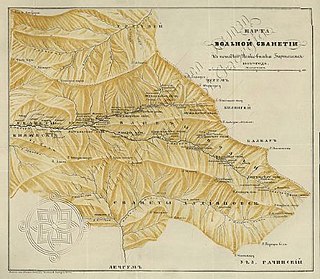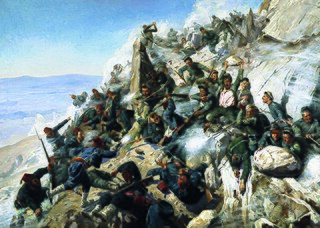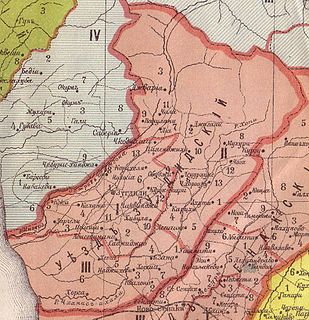 W
WThe nation of Georgia was first unified as a kingdom under the Bagrationi dynasty by the King Bagrat III of Georgia in the early 11th century, arising from a number of predecessor states of the ancient kingdoms of Colchis and Iberia. The Kingdom of Georgia flourished during the 10th to 12th centuries under King David IV the Builder and Queen Tamar the Great, and fell to the Mongol invasion by 1243, and after a brief reunion under George V the Brilliant to the Timurid Empire. By 1490, Georgia was fragmented into a number of petty kingdoms and principalities, which throughout the Early Modern period struggled to maintain their autonomy against Ottoman and Iranian domination until Georgia was finally annexed by the Russian Empire in the 19th century. After a brief bid for independence with the Democratic Republic of Georgia of 1918–1921, Georgia was part of the Transcaucasian Socialist Federative Soviet Republic from 1922 to 1936, and then formed the Georgian Soviet Socialist Republic until the dissolution of the Soviet Union.
 W
WGeorgia is a transcontinental country in the Caucasus region of Eurasia. Located at the crossroads of Western Asia and Eastern Europe, it is bounded to the west by the Black Sea, to the north by Russia, to the east by Azerbaijan, and to the south by Armenia and Turkey. The capital and largest city is Tbilisi. Georgia covers a territory of 69,700 square kilometres (26,911 sq mi), and its approximate population is about 3.718 million. Georgia is a unitary parliamentary republic, with the government elected through a representative democracy.
 W
WConstituent Assembly elections were held in the Democratic Republic of Georgia between 14 and 16 February 1919. The electoral system used was party-list proportional representation using the D'Hondt method in a single nationwide district. The result was a victory for the Social Democratic Labour Party of Georgia, which won 81% of the vote, and 109 of the 130 seats. In by-elections held in spring, they lost four seats and the Armenian Party in Georgia - Dashnaktsitiuni and the Georgian National Party both won seats.
 W
WThe Georgian coup in May 1920 was an unsuccessful attempt to take power by the Bolsheviks in the Democratic Republic of Georgia. Relying on the 11th Red Army of Soviet Russia operating in neighboring Azerbaijan, the Bolsheviks attempted to take control of a military school and government offices in the Georgian capital of Tiflis on May 3. The Georgian government suppressed the disorders in Tiflis and concentrated its forces to successfully block the advance of the Russian troops on the Azerbaijani-Georgian border. The Georgian resistance, combined with an uneasy war with Poland, persuaded the Red leadership to defer their plans for Georgia's Sovietization and recognize Georgia as an independent nation in the May 7 treaty of Moscow.
 W
WAn independence referendum was held in the Republic of Georgia on 31 March 1991. It was approved by 99.5% of voters.
 W
WThe Borchaly Uyezd was a county of the Tiflis Governorate of the Caucasus Viceroyalty of the Russian Empire and then of Democratic Republic of Georgia and of Democratic Republic of Armenia with its administrative center in Shulaveri. Now, it is part of the Armenia's region of Lori and Georgia's region of Kvemo Kartli.
 W
WThe Caucasus Military District was a military formation of the Imperial Russian Army. It was created in 1865 as the successor to the Caucasus Army, and was dissolved in 1917.
 W
WThe Caucasus Viceroyalty was Imperial Russia's administrative and political authority in the Caucasus region exercised through the offices of glavnoupravlyayushchiy and namestnik (наместник). These two terms are commonly, but imprecisely, translated into English as viceroy, which is frequently used interchangeably with governor general. More accurately, glavnoupravljajuščij is referred to as High Commissioner of the Caucasus, and namestnik as Viceroy.
 W
WThe Democratic Republic of Georgia existed from May 1918 to February 1921 and was the first modern establishment of a republic of Georgia.
 W
WFree Svaneti was a name applied to the self-governing communities of Svan highlanders, originally coined by the Imperial Russian officials and explorers of the Caucasus. These communities formed a loose confederation with a clan-based traditional system of law. As a quasi-autonomous region, Free Svaneti probably emerged with the decline of Georgian feudalism in the 15th century and was devoid of any centralized government until being subjected to the Russian Empire in 1853. The last vestiges of the Svan self-rule was brought to an end by the Russian military in 1876.
 W
WThe beginning of Georgian nationalism can be traced to the middle of the 19th century, when Georgia was part of the Russian Empire. From being more culture-focused in the Imperial Russian and Soviet periods, it went through several phases, evolving into radical ethnocentric in the late 1980s and early in the post-Soviet independence years, and to a more inclusive and civic-oriented form in the mid-2000s. However, vestiges of ethnic nationalism remain among many Georgians.
 W
WAfter the Soviet Russian Red Army invaded Georgia and the Bolsheviks took over the country early in 1921, the Parliament of the Democratic Republic of Georgia (DRG) decided that the Government should go into exile and continue to function as the National Government of Georgia (NGG).
 W
WThe nation of Georgia was first unified as a kingdom under the Bagrationi dynasty by the King Bagrat III of Georgia in the early 11th century, arising from a number of predecessor states of the ancient kingdoms of Colchis and Iberia. The Kingdom of Georgia flourished during the 10th to 12th centuries under King David IV the Builder and Queen Tamar the Great, and fell to the Mongol invasion by 1243, and after a brief reunion under George V the Brilliant to the Timurid Empire. By 1490, Georgia was fragmented into a number of petty kingdoms and principalities, which throughout the Early Modern period struggled to maintain their autonomy against Ottoman and Iranian domination until Georgia was finally annexed by the Russian Empire in the 19th century. After a brief bid for independence with the Democratic Republic of Georgia of 1918–1921, Georgia was part of the Transcaucasian Socialist Federative Soviet Republic from 1922 to 1936, and then formed the Georgian Soviet Socialist Republic until the dissolution of the Soviet Union.
 W
WThe Kutais Governorate was one of the guberniyas of the Caucasus Viceroyalty of the Russian Empire. It roughly corresponded to most of western Georgia and most of Artvin Province of Turkey between 1878 and 1917. It was created out of part of the former Georgia-Imeretia Governorate in 1846. It also included Akhaltsikhe uyezd before its cession to the Tiflis Governorate in 1867.
 W
WThis is the list of the rulers of Georgia from 1918 to the present. It includes leaders of the short-lived Democratic Republic of Georgia (1918–1921), of Soviet Georgia (1921–1991), and of the post-Soviet era.
 W
WThe Ozurget Uyezd was an uyezd (county) of the Kutais Governorate of the Caucasus Viceroyalty of the Russian Empire. It roughly corresponds to modern-day Guria. It was created in 1846 and lasted until the formation of the Democratic Republic of Georgia in 1918, when the historic name Guria was restored.
 W
WThe Russo-Turkish War of 1877–1878 was a conflict between the Ottoman Empire and the Eastern Orthodox coalition led by the Russian Empire and composed of Bulgaria, Romania, Serbia, and Montenegro. Fought in the Balkans and in the Caucasus, it originated in emerging 19th-century Balkan nationalism. Additional factors included Russian goals of recovering territorial losses endured during the Crimean War of 1853–56, re-establishing itself in the Black Sea and supporting the political movement attempting to free Balkan nations from the Ottoman Empire.
 W
WThe Special Transcaucasian Committee was established on March 9, 1917, with Member of the State Duma V. A. Kharlamov as Chairman, to replace the Imperial Viceroy Grand Duke Nikolai Nikolaevich and with special instruction to establish civil administrations in areas occupied in the course of the war on the Caucasian front by the Russian Provisional Government in the Transcaucasia as the highest organ of civil administrative body. Commissars were appointed for the Terek Oblast and the Kuban Oblast, and these as well as the Committee were to carry on relations with central government institutions through a Commissar for Caucasian Affairs in Petrograd attached to the Provisional Government.
 W
WTiflis Governorate was one of the guberniyas of the Caucasus Viceroyalty of the Russian Empire with its centre in Tiflis. In 1897 it constituted 44,607 sq. kilometres in area and had a population of 1,051,032 inhabitants. The governorate used to border Elisabethpol Governorate, Erivan Governorate, Kutais Governorate, Zakatal Okrug, Dagestan Oblast, Terek Oblast, and Kars Oblast. It covered present southeastern Georgia, northern Armenia and northwestern Azerbaijan.
 W
WThe Transcaucasian Democratic Federative Republic also known as the Transcaucasian Federation, was a short-lived South Caucasian state extending across what are now the modern-day countries of Armenia, Azerbaijan and Georgia, plus parts of eastern Turkey as well as Russian border areas. The state only lasted for a month before Georgia declared independence, followed shortly by Azerbaijan and Armenia.
 W
WThe Transcaucasian Socialist Federative Soviet Republic, also known as the Transcaucasian Soviet Federative Socialist Republic, was a republic of the Soviet Union that existed from 1922 to 1936.
 W
WThe Zugdidi Uyezd was an uyezd (county) of the Kutais Governorate of the Caucasus Viceroyalty of the Russian Empire. It was created in 1846 and lasted until the formation of the Democratic Republic of Georgia in 1918.